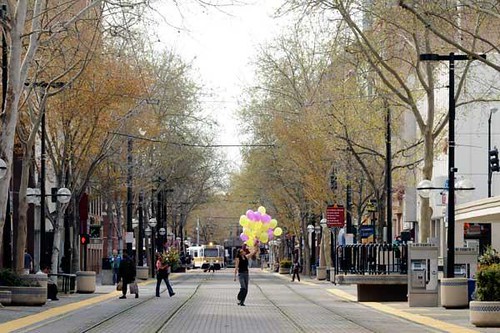Today's trends with pedestrian malls
For a variety of reasons, I tend to not favor exclusively pedestrian malls. My reasons center around pedestrian traffic. Few places have enough people to keep an exclusively pedestrian place active throughout the day and into the evening. With activity vacuums, problems accumulate. As someone once wrote, "plants don't activate spaces, people do."
This article from the Sacramento Business Journal, "K Street: Last of the pedestrian malls," discusses K Street in Sacramento, the recent history and trends of pedestrian malls, and ponders the future of the pedestrian mall in Sacramento.

Dennis McCoy Sacramento Business Journal. Wednesday afternoon saw little traffic down K Street mall, dominated by light-rail tracks but few people.
Note that K Street in Sacramento isn't the last of the pedestrian malls. First, it's important to distinguish between pedestrian only malls and pedestrian + transit malls. There are number of the latter, such as 16th Street in Denver and Nicollet Mall in Minneapolis. And there are some extant pedestrian malls that are likely to remain. Interesting that many are in college towns, like Boulder and Charlottesville. But there are others too, such as in Burlington, Vermont.
The key is being adjacent to many many pedestrians (such as college students living on a residential campus, most not having cars).
Also see these past blog entries:
-- Pedestrian Malls (2007)
-- How to f*** up 17th Street NW in Dupont Circle (2007)
-- Now I know why Boulder's Pearl Street Mall is the exception that proves the rule about the failures of pedestrian malls (2005)
Labels: commercial district revitalization, pedestrian malls, urban design/placemaking



1 Comments:
Building a pedestrian or transit mall is not always a good idea. To work, one must already be surrounded by a critical mass of pedestrians. But if it’s used to revitalize a declining street, it will only accelerate that street’s decline by further isolating it.
That said, the most overdue of these potential malls in America is Market Street in San Francisco. It’s the city’s most heavily trafficked one for transit, bikes and pedestrians. But it is now being congested by automobiles, which are mostly driven by people looking for parking—even though there’s none on the street. These autos should be disallowed, so that Market becomes a transit mall. To read about what the city is doing to encourage this visit:
http://bigcitysparkplug.com/2012/12/10/ch-14-building-a-better-market-street-the-transit-mall-proposal-in-san-francisco-ca/
Post a Comment
<< Home